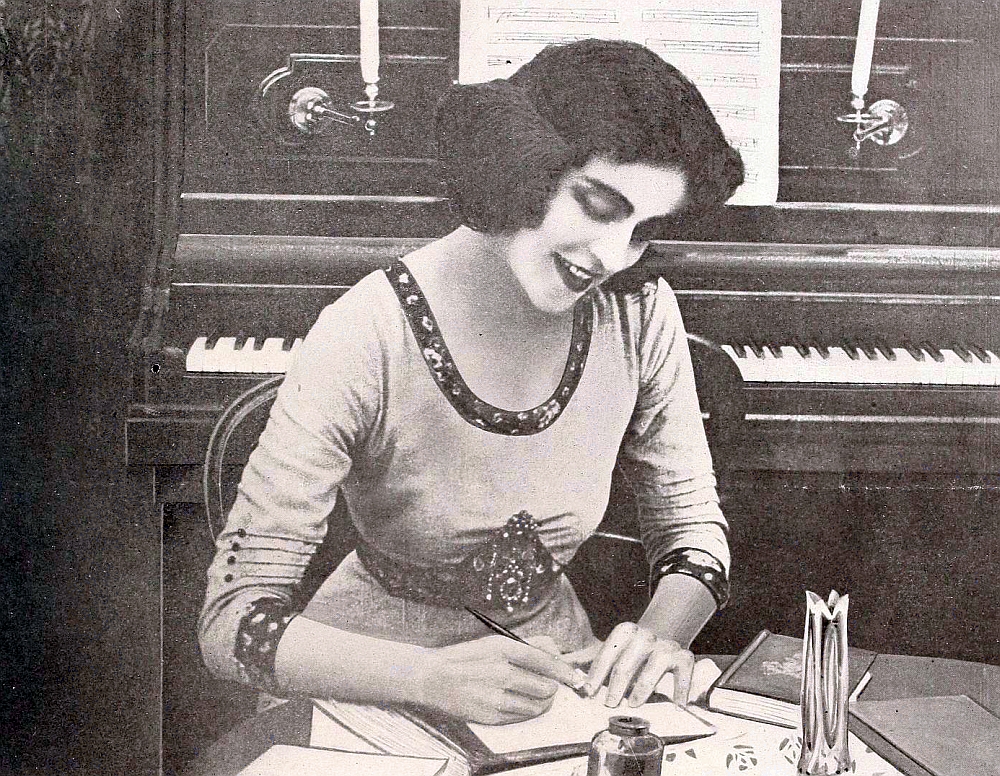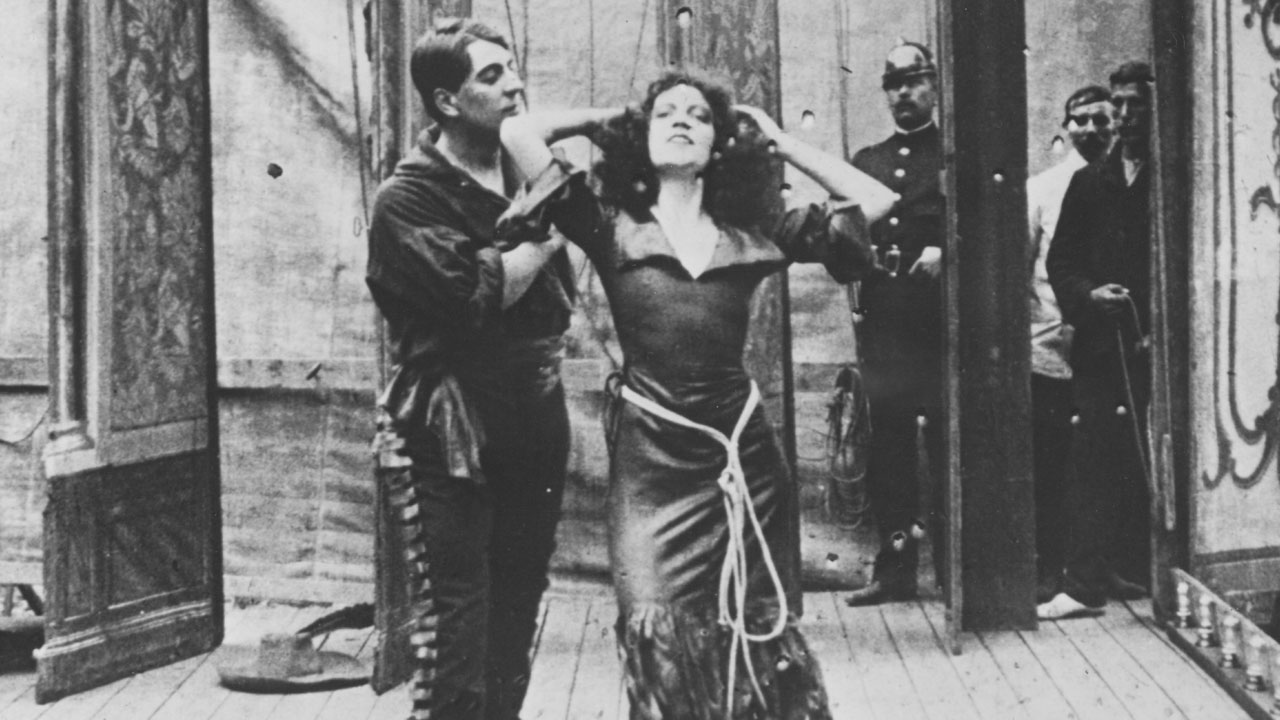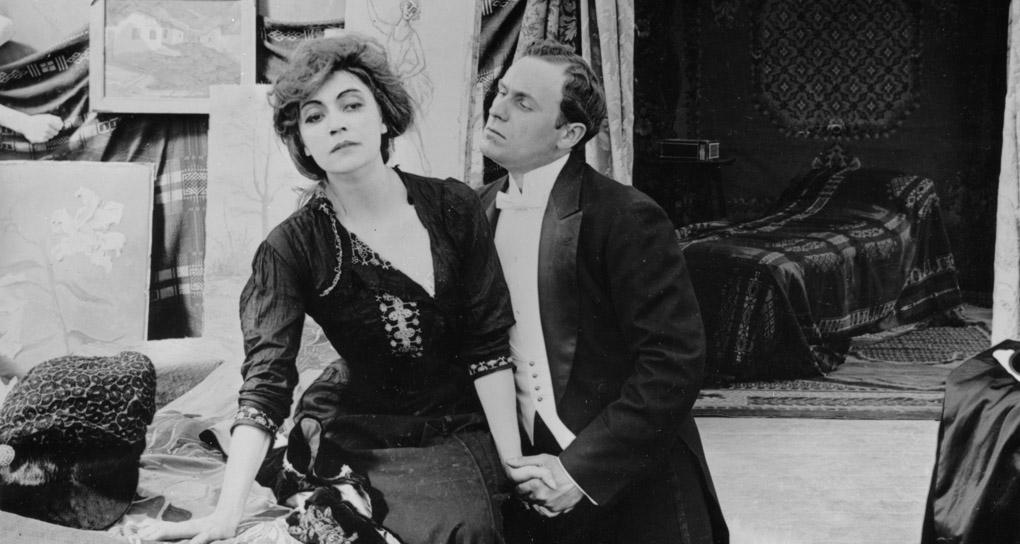Muito tempo atrás, as estrelas de cinema não recebiam crédito
nem no começo nem ao final dos filmes. Esta foi a maneira que os primeiros
cineastas encontraram para evitar que atores e atrizes ficassem famosos demais,
o que os faria demandar salários maiores. Mas logo antes de descobrirem que a
Cachinhos Dourados era a atriz canadense Mary Pickford, que iria se tornar uma
superestrela nos EUA, outra superestrela apareceu do outro lado do Atlântico:
Asta Nielsen. Com uma dança lasciva em seu primeiro filme, “O Abismo /
Afgrunden” de 1910, Nielsen se tornou uma sensação do dia para a noite.
Once upon a time, film stars didn’t receive credit on screen.
It was the way the first filmmakers found to not let the actors and actresses
become too famous, which would lead to a claim for higher salaries. But just
before Little Goldilocks was discovered to be Canadian actress Mary Pickford,
who would become a superstar in American cinema, another superstar emerged on
the other side of the Atlantic: Asta Nielsen. With a lascivious dance in her
first film, 1910’s “The Abyss / Afgrunden”, Nielsen became an overnight sensation.
Um homem e uma mulher se conhecem num bonde. O
homem é Knud Svane (Robert Dinesen) e a mulher é Magda Vang (Asta Nielsen).
Knud convida Magda para passar uns dias em sua casa de campo durante o verão, e
lá ela o convence a assistir a uma performance de um circo itinerante. No circo
Magda conhece o artista Rudolf Stern (Paul Reumert), se apaixona e foge com
ele. Ela terá seu felizes para sempre? Veremos depois de 38 minutos de
projeção.
A man and a woman meet on a trolley. The man is Knud Svane
(Robert Dinesen) and the woman is Magda Vang (Asta Nielsen). Knud invites Magda
to his country home during summer, and there she convinces him to watch a
performance from a traveling circus. At the circus Magda meets performer Rudolf
Stern (Paul Reumert), falls in love and runs away with him. Will she get a
happily ever after? After 38 minutes of projection, we shall see.
A sequência de dança sugestiva, chamada de “dança
Gaucho”, envolve Asta Nielsen esfregando seu corpo, totalmente vestida, num
homem que está amarrado por uma corda. A sequência foi considerada escandalosa
e censurada nos EUA, Noruega e Suécia, mas foi uma sensação no resto da Europa.
Hoje, não vemos nada de errado nem mesmo de sensual na sequência, o que mostra
como os tempos mudaram.
The suggestive dance sequence, called “the Gaucho dance”,
involves Asta Nielsen rubbing her fully dressed body in a man who is tied with
a rope. The sequence was considered scandalous and censored in the US, Norway
and Sweden but was a sensation in the rest of Europe. Nowadays, we see nothing
wrong nor even sensual about the sequence, a sign of how times have changed.
“O Abismo” foi escrito e dirigido por Urban
Gad, que se casaria com Asta em 1912. Eles se mudariam para a Alemanha no mesmo
ano, onde Nielsen teria uma bem-sucedida carreira, com Gad dirigindo-a em 30
filmes. Eles se separaram em 1918, quando também terminou a parceria
profissional. Asta Nielsen ficou tão famosa em tão pouco tempo que em 1911 foi
eleita a maior estrela de cinema numa enquete feita na Rússia.
“The Abyss” was written and directed by Urban Gad, who would
marry Asta in 1912. They would move to German that same year, where Nielsen
enjoyed a successful career, with Gad directing her in 30 movies. They split in
1918, when the professional partnership also ended. Asta Nielsen became so
famous and so quickly that in 1911 she was voted the biggest film star in a
poll held in Russia.
Em 1911, Nielsen fez “A Bailarina /
Balletdanserinden” com o diretor August Blom, logo antes de partir para Berlim.
Neste filme, ela interpreta Camille, uma bailarina que faz sucesso nos palcos,
mas sua vida pessoal é mais complicada: ela está apaixonada por Jean (Johannes
Poulsen), que a trai com uma mulher casada, Yvette Simon (Karen Poulsen).
Depois de posar para um pintor, Paul (Valdemar Psilander), ela fica dividida
entre os dois homens.
In 1911, Nielsen made “The Ballet Dancer / Balletdanserinden”
with director August Blom, just before leaving to Berlin. In this movie, she
plays Camille, a ballet dancer who finds professional success on stage, but her
personal life is more complicated: she is in love with Jean (Johannes Poulsen),
who cheats on her with a married woman, Yvette Simon (Karen Poulsen). After
posing for a painter, Paul (Valdemar Psilander), she becomes torn between the
two men.
Também de 1911 é “O Sonho Negro / Den Sorte Drøm”,
um dos mais antigos longas-metragens preservados, no qual Nielsen interpreta a
acrobata equestre Stella, por quem dois homens se apaixonam. Ela escolhe o
Conde Waldberg (Valdemar Psilander), desprezando o joalheiro Hirsch (Gunnar
Helsengreen). Há um duelo entre os dois homens num jogo de cartas, no qual
Waldberg perde todas as suas posses, e Stella tem de intervir, sem que ele
saiba, roubando um colar de Hirsch. O ciúme consome Waldberg e o que se segue é
uma tragédia.
Also from 1911 is “The Black Dream / Den Sorte Drøm”, one of
the earliest surviving feature-length films, in which Nielsen plays the
equestrian acrobat Stella, with whom two men fall in love. She chooses Count
Waldberg (Valdemar Psilander) over the jeweler Hirsch (Gunnar Helsengreen).
There is a duel between the two men in the card table, when Waldberg loses all
his possessions, and Stella has to intervene, without him knowing, by stealing
a necklace from Hirsch. Jealousy consumes Waldberg and tragedy follows.
Já na Alemanha em 1912, Asta Nielsen e Urban
Gad fizeram o melodrama “Pobre Jenny / Die Arme Jenny”, no qual ela interpreta
o papel-título, uma jovem mulher que precisa cuidar de seus irmãozinhos. Um dia
ela é beijada por um homem, Eduard Reinhold (Leo Peukert) contra a vontade dela,
mas ela aceita sair com ele. Depois de passar a noite com o homem, ela é
expulsa de casa. Ela então vai para a cidade grande e se torna dançarina... até
que ela reencontra Eduard e percebe que não esqueceu seu primeiro amor.
Already in German in 1912, Asta Nielsen and Urban Gad made
the melodrama “Poor Jenny / Die Arme Jenny”, in which she plays the title role,
a young woman who has to take care of her little siblings. One day she is
kissed by a man, Eduard Reinhold (Leo Peukert), against her will, but agrees to
go out with him. After spending the night with him, she is expelled from home.
She then goes to the big city and becomes a dancer… until she meets Eduard
again and realizes she didn’t forget her first love.
Também em 1912, Nielsen e Gad se juntaram
novamente para fazer “A Garota sem Pátria / Das Mädchen ohne Vaterland”. Neste
curta, Asta interpreta a cigana Zidra, que é contratada por um homem do
exército para uma missão secreta. Esperteza e sedução serão suas armas, mas ela
não imaginava que se apaixonaria pelo tenente que tem de espionar.
Also in 1912, Nielsen and Gad teamed up again to make “A
Romany Spy / Das Mädchen ohne Vaterland”. In this short, Asta plays gypsy girl
Zidra, who is hired by a military man for a secret mission. Smartness and
seduction will be her weapons, but she didn’t imagine that she would fall in
love with the lieutenant she was supposed to spy on.
Os filmes de Asta Nielsen do começo da década
de 1910 não apenas mostram por que ela se tornou uma superestrela mas também
nos convencem de que o primeiro cinema é muito mais sofisticado do que o senso
comum nos faz acreditar. As histórias são atraentes, com tramas complexas, e as
técnicas do fazer cinematográfico ainda estavam sendo desenvolvidas, por isso
há muita experimentação. Acima de tudo, há Asta Nielsen e sua persona
cinematográfica sexy e ousada, perfeita para a primeira superestrela do cinema.
Asta Nielsen’s films from the early 1910s not only show why
she became a superstar but also convince us that early cinema is much more
sophisticated than the common sense made us believe. The storytelling is
compelling, with complex plots, and the filmmaking techniques were still being
developed, so there is experimentation. Above all, there is Asta Nielsen and
her sexy, bold screen persona, perfect for the first female film superstar.








Thank you for introducing me to Asta Nielsen -- I'd never heard of her before. This film sounds interesting, and I'd also like to check out some of her other work.
ReplyDelete-- Karen